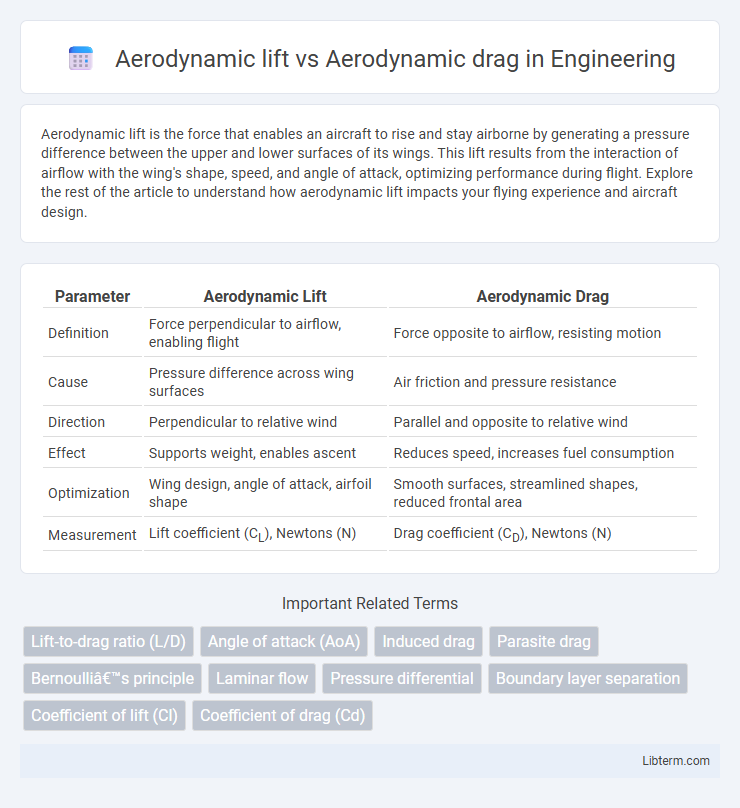Aerodynamic lift is the force that enables an aircraft to rise and stay airborne by generating a pressure difference between the upper and lower surfaces of its wings. This lift results from the interaction of airflow with the wing's shape, speed, and angle of attack, optimizing performance during flight. Explore the rest of the article to understand how aerodynamic lift impacts your flying experience and aircraft design.
Table of Comparison
| Parameter | Aerodynamic Lift | Aerodynamic Drag |
|---|---|---|
| Definition | Force perpendicular to airflow, enabling flight | Force opposite to airflow, resisting motion |
| Cause | Pressure difference across wing surfaces | Air friction and pressure resistance |
| Direction | Perpendicular to relative wind | Parallel and opposite to relative wind |
| Effect | Supports weight, enables ascent | Reduces speed, increases fuel consumption |
| Optimization | Wing design, angle of attack, airfoil shape | Smooth surfaces, streamlined shapes, reduced frontal area |
| Measurement | Lift coefficient (CL), Newtons (N) | Drag coefficient (CD), Newtons (N) |
Understanding Aerodynamic Lift and Drag
Aerodynamic lift is the force generated perpendicular to the relative airflow, allowing an aircraft to rise and maintain altitude by exploiting pressure differences across the wing surfaces. Aerodynamic drag acts parallel and opposite to the airflow, resisting the aircraft's motion and reducing efficiency by converting kinetic energy into heat and turbulence. Understanding the balance between lift and drag is crucial for optimizing aircraft performance, fuel efficiency, and stability during flight.
The Science Behind Aerodynamic Forces
Aerodynamic lift is generated by the pressure difference between the upper and lower surfaces of an airfoil, created as air flows faster over the curved top surface, following Bernoulli's principle and Newton's third law. Aerodynamic drag results from air resistance and friction opposing an object's motion, composed of parasitic drag, including form and skin friction drag, and induced drag caused by wingtip vortices. Understanding the balance between lift and drag is essential in aerospace engineering to optimize aircraft performance, fuel efficiency, and stability.
Key Principles of Aerodynamic Lift
Aerodynamic lift arises primarily from the pressure differences created by airflow over an airfoil, where faster airflow on the upper surface reduces pressure compared to the higher pressure on the lower surface, following Bernoulli's principle. The angle of attack significantly influences lift by altering the airflow direction and pressure distribution, while the shape of the airfoil optimizes smooth airflow and maximizes lift-to-drag ratio. Understanding these key principles allows engineers to design aircraft wings that generate sufficient lift to overcome aerodynamic drag, ensuring efficient flight performance.
Factors Affecting Lift Generation
Lift generation in aerodynamics depends primarily on factors such as airfoil shape, angle of attack, and airspeed, with a well-designed cambered airfoil increasing pressure differences above and below the wing. The viscosity and density of air directly influence lift by affecting the airflow characteristics, while wing surface area impacts the total lift produced. Minimizing drag through smooth surfaces and optimal wing design helps maximize the lift-to-drag ratio, crucial for efficient flight performance.
What Causes Aerodynamic Drag?
Aerodynamic drag is primarily caused by the resistance air exerts on a moving object, resulting from friction and pressure differences around the object's surface. Two main types of drag are form drag, caused by the shape and frontal area disrupting airflow, and skin friction drag, caused by the air's viscosity interacting with the object's surface. Turbulence and flow separation further increase drag by creating pressure imbalances and chaotic airflow patterns behind the object.
Types of Aerodynamic Drag
Aerodynamic drag consists primarily of two main types: parasitic drag and induced drag. Parasitic drag includes form drag, caused by the shape of the aircraft, and skin friction drag, resulting from the surface roughness of the aircraft. Induced drag is generated by the creation of lift, typically increasing with higher angles of attack and lower airspeeds.
Comparing Lift and Drag: Core Differences
Aerodynamic lift is the force generated perpendicular to the airflow, allowing an aircraft to rise and maintain altitude, while aerodynamic drag acts parallel and opposite to the airflow, resisting forward motion. Lift depends primarily on wing shape, airspeed, and angle of attack, whereas drag increases with airspeed and surface friction. Understanding the balance between lift and drag is crucial for optimizing aircraft performance, fuel efficiency, and flight stability.
Effects of Lift-to-Drag Ratio
The lift-to-drag ratio (L/D ratio) is a critical parameter in aerodynamics that quantifies an aircraft's efficiency by comparing the amount of lift generated to the aerodynamic drag it experiences. A higher L/D ratio indicates better performance, allowing for longer gliding distances and reduced fuel consumption by minimizing drag while maintaining sufficient lift. Optimizing the L/D ratio is essential in designing wings and airfoils to maximize flight endurance, improve speed, and enhance overall aerodynamic efficiency.
Applications in Aircraft Design
Aerodynamic lift is crucial in aircraft design for generating upward force to counteract weight and enable flight, optimized through wing shape, angle of attack, and airfoil design. Aerodynamic drag, comprising parasitic and induced drag, must be minimized to improve fuel efficiency and aircraft performance by refining surface smoothness, streamlining fuselage, and optimizing winglets. Balancing lift and drag through computational fluid dynamics (CFD) and wind tunnel testing ensures efficient aircraft stability, control, and maneuverability in various flight regimes.
Innovations to Optimize Lift and Reduce Drag
Innovations in aerodynamic lift focus on advanced wing designs such as adaptive morphing surfaces and biomimetic structures that enhance lift efficiency by optimizing airflow patterns. Concurrently, breakthroughs in drag reduction utilize laminar flow control, surface texturing like riblets, and active flow management systems to minimize turbulence and skin friction. These technologies collectively improve aircraft performance by maximizing lift-to-drag ratios, leading to increased fuel efficiency and reduced emissions.
Aerodynamic lift Infographic

 libterm.com
libterm.com